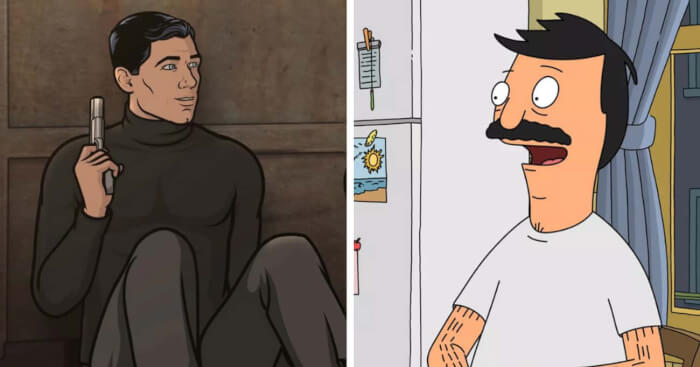14 Actors You Love Even Though You Hardly See Their Real Face
Many outstanding actors in Hollywood have blurred the boundaries between truth and fiction. It seems to reason that, with each character they play, performers who have gathered an astounding number of parts under their belts become more and more well-known. The truth is that some of the best actors in the business whose faces remain unknown to the public eye while concealed by masks or prosthetics.
This leads to a peculiar situation where we can recognize them by their credit names but not their face. It proves that the real unsung heroes who made our favorite blockbuster films and cartoon programs are hardly ever acknowledged. But it doesn't imply their abilities should go unnoticed just because we hardly remember their real faces.
Today, the actors listed below may already hold a special place in your heart, even if you have no idea what some of them look like.
Due in part to his attention to detail, Oz was a fantastic puppeteer for many years on many Jim Henson projects. Oz explained that he would give each of his puppets a distinctive personality, including a backstory, in the 2017 documentary Muppet Guys Talking. Oz has discussed how his personality even influenced his work:
"We'd pick parts of ourselves and put them into the puppets. Of all the characters I performed inside I'd say I'm closest to Grover and Fozzie (Bear). We all hide Grover inside ourselves - the pure parts of ourselves that we have to be careful to let out unless we know and trust someone. I see parts of them in me all through Talking: Bert who is boring, Fozzie trying to make people laugh."
Of course, Oz is also in charge of providing Jedi Master Yoda his voice. The English-born puppeteer, who performed the Yoda puppet for all of the Star Wars films before 2002's Attack of the Clones, did more than merely give the figure a voice. Yoda used CGI for the first time in that episode. Oz persisted in speaking in the Jedi Master's voice, nevertheless.
The artist also directs feature films. In addition to Little Shop of Horrors, Dirty Rotten Scoundrels, What About Bob?, In & Out, and Bowfinger, he has worked behind the camera on numerous more successful comedies. He also oversaw Marlon Brando's final acting performance in The Score, a 2001 heist film.
Jones frequently works in the monster department while wearing convincing prosthetics and heavy makeup that leads viewers to believe he is a special effect construct. Mimic, Crimson Peak, and the Best Picture-winning The Shape of Water are just a few of his other noteworthy creature credits. Jones most recently appeared as Commander Saru in the CBS All Access television series Star Trek: Discovery, where he showcased his remarkable hidden talents.
Having collaborated with Jones on six major motion pictures, Del Toro discussed what makes the actor so unique:
"A creature performer needs to be a very odd combination of a marathon runner and a mime, who can express himself through layers and layers of latex and acrylic and silicon. It's a very, very rare discipline... There are very, very few that are actual actors, in my opinion, that go beyond being able to work in a suit or under makeup. Doug is a proper actor. When you need that level of finesse, Doug is the only one I've met that I trust with that level of commitment and craftsmanship and artistry."
Beyond Middle-earth, Serkis has made an impression by brilliantly capturing the essence of Caesar, the main character of the Planet of the Apes reboot trilogy, as well as by giving King Kong in the 2005 remake of the same name a startlingly complex emotional core and lending his talents to the Star Wars franchise as Supreme Leader Snoke.
What has made Serkis such a trailblazer in his particular acting discipline? His attention to detail is everything. Serkis flew to Rwanda to study gorillas and apes in the wild in order to get ready for his role as King Kong. Then he made a comparison between the behavior of the animals in the wild and in the zoo where they were kept in captivity.
For Serkis, there is no distinction between a motion-capture performer and a traditional actor. He clarified:
"It's crucial that people do understand that when you're approaching a role, there is no difference between performance-capture technology and conventional acting. You're not inhibited by layers of prosthetic makeup. You can actually play something much more truthfully. The technology has arrived at a point where the fidelity to the original performance is much greater."
As Pennywise in the miniseries adaption of Stephen King's It, the English actor played a masked character wearing full clown makeup. Curry's performance as the transvestite mad scientist Dr. Frank-N-Furter in The Rocky Horror Picture Show is possibly his most well-known performance. Curry's face is covered in a ton of makeup in the cult musical hit, but his features and voice are always recognizable.
Curry had to endure several hours of makeup each day to portray the devil, sometimes known as the Lord of Darkness, in Ridley Scott's 1985 dark fantasy adventure Legend. Under the thick red makeup and substantial fiberglass horns, his face was barely discernible. Curry, though, acted his way through the mask thanks to his uniqueness and character in his swagger and delivery.
In the 1930s, Blanc started working as an animator for Warner Bros., where he eventually voiced approximately 90% of the company's characters. For example, Porky Pig, Bugs Bunny, Woody Woodpecker, Tweety Bird, Pepé Le Pew, Daffy Duck, and the Road Runner are well-known Looney Tunes and Merrie Melodies characters.
He worked for more than 50 years. In total, Blanc lent his voice to nearly 3,000 animated characters. Additionally, he contributed to a number of comedy programs, including Jack Benny, The Burns and Allen Show, and Abbott and Costello. Blanc performed the voices of cartoon characters for Hanna-Barbera in the 1960s, including Mr. Spacely from The Jetsons and Barney Rubble from The Flinstones.
One of the few occasions that Blanc's face was truly visible to television viewers was during a 1980s appearance on The David Letterman Show. Letterman questioned Blanc on how he came up with the many voices for cartoon characters. Blanc's response might assist in explaining his genius:
"They show me a picture of the character, and then they show me a storyboard that shows what the character is going to do in the cartoon. From this, I have to create the voice. Like, Bugs they said was a "tough little stinker." So I thought, "Which is the toughest voice in this country? The Brooklyn or the Bronx?" So I, uh, put the two of them together, and that's how I got the voice of Bugs, doc!"
Early in his career, the actor was content to accept parts in works in which he could conceal his face. In 1981's Quest for Fire, he made his debut in a feature film as a caveman. His first major television appearance was as the titular beast opposite Linda Hamilton in the three-season series Beauty and the Beast in 1987.
His long-standing collaboration with genre icon Guillermo del Toro, who first directed Perlman in his 1993 directorial debut, Cronos, has been one of the foundations of his enduring success. Their joint efforts eventually resulted in their own comic book brand. Perlman chose to play the titular Hellboy in del Toro's 2004 adaption, but not because he could conceal his face beneath the monster's thick makeup. Perlman was merely smitten by the persona. It's undoubtedly the best comic book character a performer could ever hope to portray, he remarked. In so many ways, this person is gloriously substantial. In the film's sequel, Hellboy II: The Golden Army, Perlman returned to the character.
How talented is Perlman? Del Toro wouldn't make Hellboy without the actor already committed to playing the lead. Del Toro was just starting out in Hollywood in the late 1990s, while Perlman was only recognized as a character actor. Seven years passed. In 2002, after Blade II became a box-office success, he finally gained some influence. Once the studio gave the go-ahead for Perlman to play the titular character, del Toro got to work.
The actor claims that he feels more at ease with himself now. In the popular FX series Sons of Anarchy, Perlman played the tough-talking biker Clay Morrow, who is now widely recognized.
After that, Davis kept getting roles in huge films, such as Labyrinth, where he portrayed a goblin. His disguise and cosmetics kept his face concealed in that movie.
Davis has played a number of noteworthy parts in big-budget movies. In the Harry Potter films, he was heavily prosthetic and heavily make upped to play Professor Filius and Griphook. In the 1980s, he appeared on television in the BBC production of C.S. Lewis's Prince Caspian and the Voyage of the Dawn Treader, as the talking mouse Reepicheep. Additionally, he portrayed the antagonist in the 1993 horror film Leprechaun and its five silly sequels. In each of those roles, a costume or prosthesis was used to conceal Davis's face.
Nevertheless, the actor has been given the chance to play more conventional on-screen parts. He co-created and co-starred with Ricky Gervais in the 2011 mockumentary series Life's Too Short. In the meta-series, Davis plays a deeply neurotic, fictionalized version of himself navigating the competitive Entertainment business.
The English actor's positive outlook and sense of humor are largely responsible for his success. "He's arguably the most firmly planted and steady individual I've ever encountered. His children are truly remarkable; rather than keeping them away from the big, terrible world, he has made them bulletproof by instilling a sense of humor in them "explained Gervais. We had to convert Warwick into a small Hitler-type persona so that people would know what they were laughing at because he is so endowed with humanity and likable.
On the rebooted Planet of the Apes, Notary also served as the movement choreographer. His responsibility was to instruct the stuntmen on how to move convincingly to represent the three various species of apes in the movies. The devil was in the details as Notary and the ape actors studied training tapes for six weeks to observe the monkeys' precise movements.
Each ape actor used a bodysuit and a head camera to record all of their movements, according to the Notary's explanation of the process:
"Everything was with real actors equipped for mo-cap performing in real-time. We would block scenes, the actors would take positions, and then we would shoot until [director] Rupert [Wyatt] was happy with the scene. We were in grey velcro mo-cap suits with LED lights on. We were wired for sound and carried battery packs - pretty loaded up. The beauty of mo-cap is that you can play a character one way, then move to the next spot and play the same scene out, and then move again and play - then they marry them all together and you've got a giant crowd of apes. It takes about three minutes to switch from an orangutan to a gorilla to a chimp - you can become anyone at any point in time."
In the successful comedy Austin Powers: International Man of Mystery, Myers put his ability to assume many personas to the test as both the cool 1960s spy with horrible teeth Austin Powers and the wonderfully bald, evil Dr. Evil. For the follow-up film Austin Powers: The Spy Who Shagged Me, he improved his disguise skills. Myers added the wonderfully repulsive henchman, Fat Bastard, in addition to reprising the role of the villain and hero from the first movie. Myers spent four hours dressing in the fat suit that gave him the appearance of an 800-pound Scottish deliveryman. In the last Austin Powers movie, Myers also portrayed all three characters. Because of Fat Bastard, the second movie was nominated for an Academy Award for Best Makeup.
Myers as the titular mischievous cat in the fantasy comedy The Cat in the Hat from 2003. Behind the makeup, which took 2 1/2 hours to do each day of filming, his face was essentially unrecognizable. So that Myers wouldn't get too hot while filming outside, his catsuit was even created with a small air conditioner inside.
In the early 2010s, Myers largely faded from the Hollywood spotlight, though he did appear in a notable one-scene in Quentin Tarantino's Oscar-winning Inglourious Basterds, once more donning a drastically altered visage. He reappeared in an unusual way in 2017. An updated episode of The Gong Show with an orange-skinned older British emcee named Tommy Maitland as its host broadcast on ABC. When spectators looked closer, they saw that it was indeed Myers, once more disguised with makeup that made him unrecognizable. He pretended to be the TV game show host for six months.
Dorn chose to reveal his face during the audition for a role that in reality never permitted it in order to land the part:
"I did not wear makeup, but I took on the psychological guise of a Klingon. I walked into Paramount in character. No jokes. No laughing with the other actors. I sat by myself waiting for my interview. When my turn came, I walked in, didn't smile, did the reading, thanked them, and walked right out."
Over 170 credits are listed in Dorn's decades-spanning filmography, which includes cameo roles in Rocky and CHiPs. He will always be remembered, though, as the Klingon Starfleet Officer. It took so long to prepare for the role that Dorn had to spend nearly every day for 15 years sitting in a makeup chair.
The C-3PO suit would get better with time, but it would always have flaws. Daniels, who is consistently professional, flatly rejected when J.J. Abrams asked him if he wanted to only voice C-3PO for The Force Awakens and have another actor don the droid costume. "I couldn't possibly have done the voice alone. This integration is C-3PO."
In the animated television series The Lord of the Rings from 1978, Daniels also provided the voice of Legolas.
The fact that Freddy Krueger stalks his victims when they are asleep is what makes him so horrifying. He resides in their psyches and subsists on their terror. Because the villain is having so much pleasure in frightening his victims, Englund plays Krueger in a somewhat campy manner.
Englund had a lengthy acting career. Even in his early work as an episodic television actor in the 1970s and 1980s on programs like Soap, Charlie's Angels, and CHiPS, we can recognize his face. His big-screen debut was on the science fiction show V.
Englund was given the lead role in Wes Craven's 1984 film A Nightmare on Elm Street, and even though he has over 160 acting and voiceover credits to his name, Freddy Krueger will always be the character for which Englund is best known. This is true even though his face is essentially unrecognizable in the role.
Wes Craven described how Englund came up with the character's essence on his own:
"As a director, you're always trying to do that. For instance, with Robert Englund, I always encouraged him to make [Freddy] his own. In fact, from casting on, I realized the power of that man. He was ready and enthusiastic about exploring that persona in a way that came from his own imagination, as well as mine. The physicality of the character, for instance, was not necessarily on the page; much of it was Robert experimenting and improvising based on a theme. It's a little bit like Miles Davis's Kind of Blue. The melody lines for that album's songs were very simple, and they had these great players go into the recording studio - John Coltrane and Gil Evans and so forth - and they came out with something that's based on the melody lines, but everybody brought their own genius to it through improvisation. That was the secret of that film in Robert's case; he was able to take the ball and run with it."
Benjamin won the award for a best male comedic performer at the Vulture TV Awards for his roles in Bob's Burgers and Archer. For his portrayal of the egotistical, womanizing spy Archer in 2009, he was also nominated for an Emmy in the category of Outstanding Voice-Over Performance.
Despite having strong filmography, Benjamin doesn't think he is particularly skilled in his field. He stated: "When Loren [Bouchard, the man behind Bob's Burgers], casts me in a role, I'm never happy. I don't think my voice-acting skills are particularly strong. There are some exceptionally talented character actors and impressionists, such as Larry Murphy as Teddy and Dave Herman as Mr. Frond. I've just thought of a simple approach to alter the tone of my voice."
Benjamin is a skilled voiceover artist because of his ability to vary his voice. The characteristics of Archer's voice and Bob Belcher's voice are very different. Benjamin is able to take the character's personalities and produce a tone that is exactly right for the subject matter.
Skarsgrd played Pennywise the Dancing Clown, one of the scariest horror movie villains of the modern era. In the 2017 Stephen King adaption It and the 2019 follow-up It Chapter Two, he played the spooky, white-faced clown.
In both television and movies, terrifying clowns have appeared frequently. Why is Skarsgrd's interpretation of Pennywise so terrifying? It's not even about the bloodied clown outfit or makeup. He demonstrated that even the smallest facial movement can conjure up something absolutely evil by flashing the horrifying Pennywise smile on Instagram without the need for CGI or makeup.
James McAvoy, a fellow actor, acknowledged that he was utterly afraid while they were filming It Chapter Two because of Skarsgrd. The Scottish actor claimed in an interview from 2019 that "He's incredible. Skarsgrd is dreadful. He's a pretty nice person, yet he creeped me out a lot. I recall being there with the rest of the cast, all these adults, and doing crazy, freaky things with everyone. We are all saying, "I don't like being here," as we all turn to face one another. I don't enjoy acting in today's world."
This leads to a peculiar situation where we can recognize them by their credit names but not their face. It proves that the real unsung heroes who made our favorite blockbuster films and cartoon programs are hardly ever acknowledged. But it doesn't imply their abilities should go unnoticed just because we hardly remember their real faces.
Today, the actors listed below may already hold a special place in your heart, even if you have no idea what some of them look like.
#1 Frank Oz
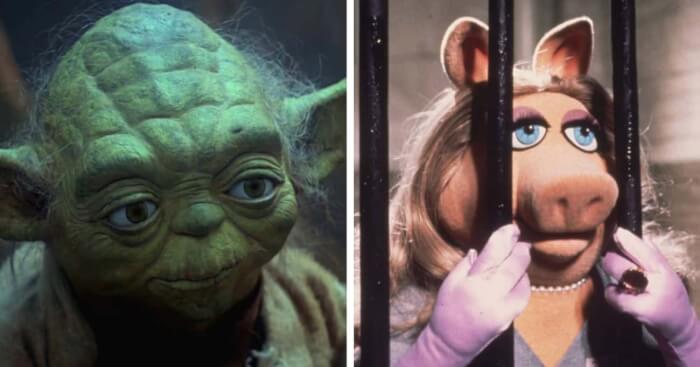 Source: 20th Century Fox / Universal Pictures
Source: 20th Century Fox / Universal Pictures
Due in part to his attention to detail, Oz was a fantastic puppeteer for many years on many Jim Henson projects. Oz explained that he would give each of his puppets a distinctive personality, including a backstory, in the 2017 documentary Muppet Guys Talking. Oz has discussed how his personality even influenced his work:
"We'd pick parts of ourselves and put them into the puppets. Of all the characters I performed inside I'd say I'm closest to Grover and Fozzie (Bear). We all hide Grover inside ourselves - the pure parts of ourselves that we have to be careful to let out unless we know and trust someone. I see parts of them in me all through Talking: Bert who is boring, Fozzie trying to make people laugh."
Of course, Oz is also in charge of providing Jedi Master Yoda his voice. The English-born puppeteer, who performed the Yoda puppet for all of the Star Wars films before 2002's Attack of the Clones, did more than merely give the figure a voice. Yoda used CGI for the first time in that episode. Oz persisted in speaking in the Jedi Master's voice, nevertheless.
The artist also directs feature films. In addition to Little Shop of Horrors, Dirty Rotten Scoundrels, What About Bob?, In & Out, and Bowfinger, he has worked behind the camera on numerous more successful comedies. He also oversaw Marlon Brando's final acting performance in The Score, a 2001 heist film.
#2 Doug Jones
 Source: Fox Searchlight Pictures / Warner Bros. / Universal Pictures
Source: Fox Searchlight Pictures / Warner Bros. / Universal Pictures
Jones frequently works in the monster department while wearing convincing prosthetics and heavy makeup that leads viewers to believe he is a special effect construct. Mimic, Crimson Peak, and the Best Picture-winning The Shape of Water are just a few of his other noteworthy creature credits. Jones most recently appeared as Commander Saru in the CBS All Access television series Star Trek: Discovery, where he showcased his remarkable hidden talents.
Having collaborated with Jones on six major motion pictures, Del Toro discussed what makes the actor so unique:
"A creature performer needs to be a very odd combination of a marathon runner and a mime, who can express himself through layers and layers of latex and acrylic and silicon. It's a very, very rare discipline... There are very, very few that are actual actors, in my opinion, that go beyond being able to work in a suit or under makeup. Doug is a proper actor. When you need that level of finesse, Doug is the only one I've met that I trust with that level of commitment and craftsmanship and artistry."
#3 Andy Serkis
 Source: 20th Century Fox / New Line Cinema / Universal Pictures
Source: 20th Century Fox / New Line Cinema / Universal Pictures
Beyond Middle-earth, Serkis has made an impression by brilliantly capturing the essence of Caesar, the main character of the Planet of the Apes reboot trilogy, as well as by giving King Kong in the 2005 remake of the same name a startlingly complex emotional core and lending his talents to the Star Wars franchise as Supreme Leader Snoke.
What has made Serkis such a trailblazer in his particular acting discipline? His attention to detail is everything. Serkis flew to Rwanda to study gorillas and apes in the wild in order to get ready for his role as King Kong. Then he made a comparison between the behavior of the animals in the wild and in the zoo where they were kept in captivity.
For Serkis, there is no distinction between a motion-capture performer and a traditional actor. He clarified:
"It's crucial that people do understand that when you're approaching a role, there is no difference between performance-capture technology and conventional acting. You're not inhibited by layers of prosthetic makeup. You can actually play something much more truthfully. The technology has arrived at a point where the fidelity to the original performance is much greater."
#4 Tim Curry
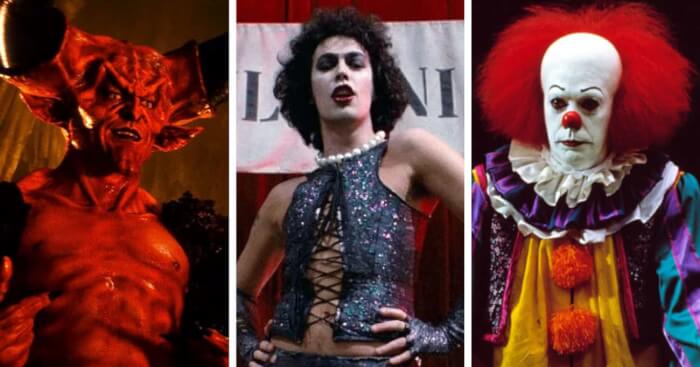 Source: Universal Pictures / 20th Century Fox / ABC
Source: Universal Pictures / 20th Century Fox / ABC
As Pennywise in the miniseries adaption of Stephen King's It, the English actor played a masked character wearing full clown makeup. Curry's performance as the transvestite mad scientist Dr. Frank-N-Furter in The Rocky Horror Picture Show is possibly his most well-known performance. Curry's face is covered in a ton of makeup in the cult musical hit, but his features and voice are always recognizable.
Curry had to endure several hours of makeup each day to portray the devil, sometimes known as the Lord of Darkness, in Ridley Scott's 1985 dark fantasy adventure Legend. Under the thick red makeup and substantial fiberglass horns, his face was barely discernible. Curry, though, acted his way through the mask thanks to his uniqueness and character in his swagger and delivery.
#5 Mel Blanc
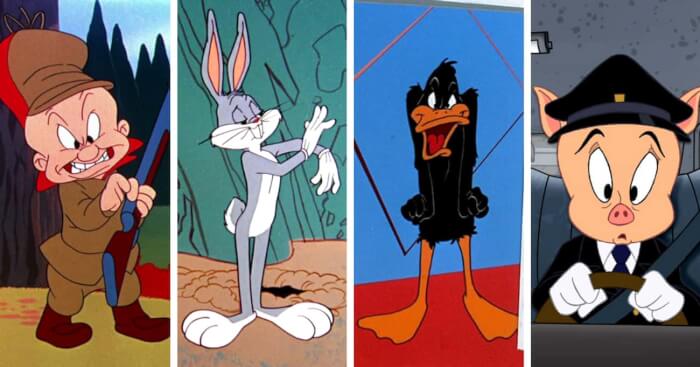 Source: Looney Tunes / Warner Bros.
Source: Looney Tunes / Warner Bros.
In the 1930s, Blanc started working as an animator for Warner Bros., where he eventually voiced approximately 90% of the company's characters. For example, Porky Pig, Bugs Bunny, Woody Woodpecker, Tweety Bird, Pepé Le Pew, Daffy Duck, and the Road Runner are well-known Looney Tunes and Merrie Melodies characters.
He worked for more than 50 years. In total, Blanc lent his voice to nearly 3,000 animated characters. Additionally, he contributed to a number of comedy programs, including Jack Benny, The Burns and Allen Show, and Abbott and Costello. Blanc performed the voices of cartoon characters for Hanna-Barbera in the 1960s, including Mr. Spacely from The Jetsons and Barney Rubble from The Flinstones.
One of the few occasions that Blanc's face was truly visible to television viewers was during a 1980s appearance on The David Letterman Show. Letterman questioned Blanc on how he came up with the many voices for cartoon characters. Blanc's response might assist in explaining his genius:
"They show me a picture of the character, and then they show me a storyboard that shows what the character is going to do in the cartoon. From this, I have to create the voice. Like, Bugs they said was a "tough little stinker." So I thought, "Which is the toughest voice in this country? The Brooklyn or the Bronx?" So I, uh, put the two of them together, and that's how I got the voice of Bugs, doc!"
#6 Ron Perlman
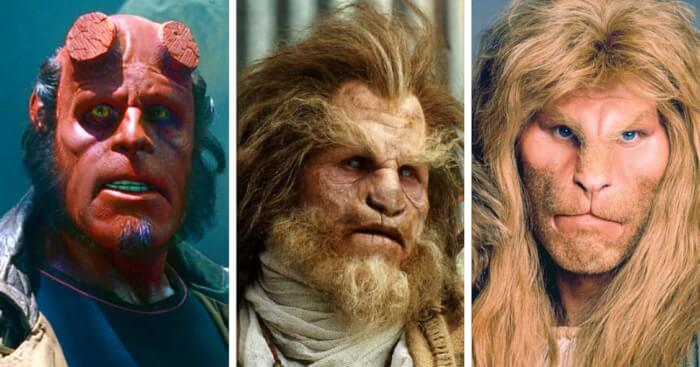 Source: Columbia Pictures / New Line Cinema / CBS
Source: Columbia Pictures / New Line Cinema / CBS
Early in his career, the actor was content to accept parts in works in which he could conceal his face. In 1981's Quest for Fire, he made his debut in a feature film as a caveman. His first major television appearance was as the titular beast opposite Linda Hamilton in the three-season series Beauty and the Beast in 1987.
His long-standing collaboration with genre icon Guillermo del Toro, who first directed Perlman in his 1993 directorial debut, Cronos, has been one of the foundations of his enduring success. Their joint efforts eventually resulted in their own comic book brand. Perlman chose to play the titular Hellboy in del Toro's 2004 adaption, but not because he could conceal his face beneath the monster's thick makeup. Perlman was merely smitten by the persona. It's undoubtedly the best comic book character a performer could ever hope to portray, he remarked. In so many ways, this person is gloriously substantial. In the film's sequel, Hellboy II: The Golden Army, Perlman returned to the character.
How talented is Perlman? Del Toro wouldn't make Hellboy without the actor already committed to playing the lead. Del Toro was just starting out in Hollywood in the late 1990s, while Perlman was only recognized as a character actor. Seven years passed. In 2002, after Blade II became a box-office success, he finally gained some influence. Once the studio gave the go-ahead for Perlman to play the titular character, del Toro got to work.
The actor claims that he feels more at ease with himself now. In the popular FX series Sons of Anarchy, Perlman played the tough-talking biker Clay Morrow, who is now widely recognized.
#7 Warwick Davis
 Source: Warner Bros. / 20th Century Fox / Buena Vista Pictures
Source: Warner Bros. / 20th Century Fox / Buena Vista Pictures
After that, Davis kept getting roles in huge films, such as Labyrinth, where he portrayed a goblin. His disguise and cosmetics kept his face concealed in that movie.
Davis has played a number of noteworthy parts in big-budget movies. In the Harry Potter films, he was heavily prosthetic and heavily make upped to play Professor Filius and Griphook. In the 1980s, he appeared on television in the BBC production of C.S. Lewis's Prince Caspian and the Voyage of the Dawn Treader, as the talking mouse Reepicheep. Additionally, he portrayed the antagonist in the 1993 horror film Leprechaun and its five silly sequels. In each of those roles, a costume or prosthesis was used to conceal Davis's face.
Nevertheless, the actor has been given the chance to play more conventional on-screen parts. He co-created and co-starred with Ricky Gervais in the 2011 mockumentary series Life's Too Short. In the meta-series, Davis plays a deeply neurotic, fictionalized version of himself navigating the competitive Entertainment business.
The English actor's positive outlook and sense of humor are largely responsible for his success. "He's arguably the most firmly planted and steady individual I've ever encountered. His children are truly remarkable; rather than keeping them away from the big, terrible world, he has made them bulletproof by instilling a sense of humor in them "explained Gervais. We had to convert Warwick into a small Hitler-type persona so that people would know what they were laughing at because he is so endowed with humanity and likable.
#8 Terry Notary
 Source: 20th Century Fox / Walt Disney Studios Motion Pictures / Warner Bros.
Source: 20th Century Fox / Walt Disney Studios Motion Pictures / Warner Bros.
On the rebooted Planet of the Apes, Notary also served as the movement choreographer. His responsibility was to instruct the stuntmen on how to move convincingly to represent the three various species of apes in the movies. The devil was in the details as Notary and the ape actors studied training tapes for six weeks to observe the monkeys' precise movements.
Each ape actor used a bodysuit and a head camera to record all of their movements, according to the Notary's explanation of the process:
"Everything was with real actors equipped for mo-cap performing in real-time. We would block scenes, the actors would take positions, and then we would shoot until [director] Rupert [Wyatt] was happy with the scene. We were in grey velcro mo-cap suits with LED lights on. We were wired for sound and carried battery packs - pretty loaded up. The beauty of mo-cap is that you can play a character one way, then move to the next spot and play the same scene out, and then move again and play - then they marry them all together and you've got a giant crowd of apes. It takes about three minutes to switch from an orangutan to a gorilla to a chimp - you can become anyone at any point in time."
#9 Mike Myers
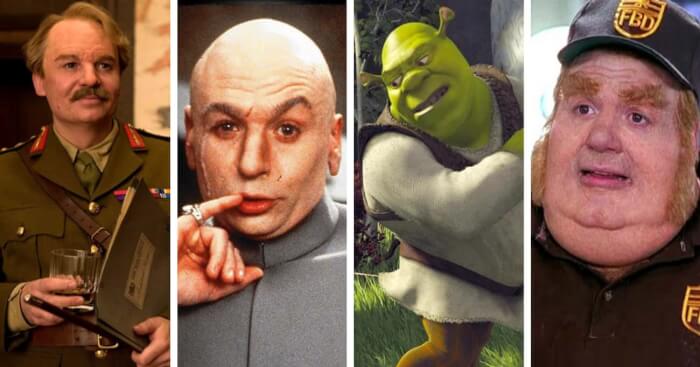 Source: The Weinstein Company / New Line Cinema / DreamWorks Pictures
Source: The Weinstein Company / New Line Cinema / DreamWorks Pictures
In the successful comedy Austin Powers: International Man of Mystery, Myers put his ability to assume many personas to the test as both the cool 1960s spy with horrible teeth Austin Powers and the wonderfully bald, evil Dr. Evil. For the follow-up film Austin Powers: The Spy Who Shagged Me, he improved his disguise skills. Myers added the wonderfully repulsive henchman, Fat Bastard, in addition to reprising the role of the villain and hero from the first movie. Myers spent four hours dressing in the fat suit that gave him the appearance of an 800-pound Scottish deliveryman. In the last Austin Powers movie, Myers also portrayed all three characters. Because of Fat Bastard, the second movie was nominated for an Academy Award for Best Makeup.
Myers as the titular mischievous cat in the fantasy comedy The Cat in the Hat from 2003. Behind the makeup, which took 2 1/2 hours to do each day of filming, his face was essentially unrecognizable. So that Myers wouldn't get too hot while filming outside, his catsuit was even created with a small air conditioner inside.
In the early 2010s, Myers largely faded from the Hollywood spotlight, though he did appear in a notable one-scene in Quentin Tarantino's Oscar-winning Inglourious Basterds, once more donning a drastically altered visage. He reappeared in an unusual way in 2017. An updated episode of The Gong Show with an orange-skinned older British emcee named Tommy Maitland as its host broadcast on ABC. When spectators looked closer, they saw that it was indeed Myers, once more disguised with makeup that made him unrecognizable. He pretended to be the TV game show host for six months.
#10 Michael Dorn
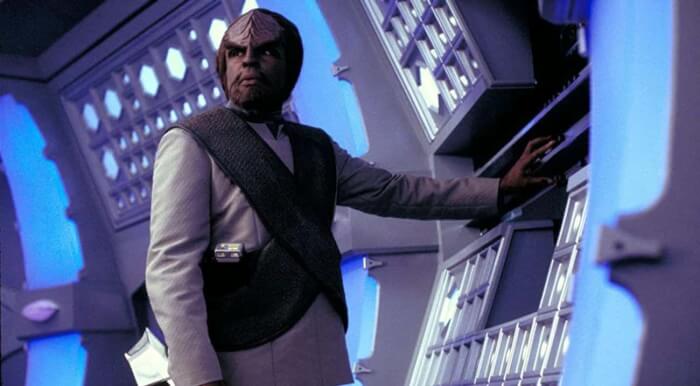 Source: Star Trek: Insurrection / Paramount Pictures
Source: Star Trek: Insurrection / Paramount Pictures
Dorn chose to reveal his face during the audition for a role that in reality never permitted it in order to land the part:
"I did not wear makeup, but I took on the psychological guise of a Klingon. I walked into Paramount in character. No jokes. No laughing with the other actors. I sat by myself waiting for my interview. When my turn came, I walked in, didn't smile, did the reading, thanked them, and walked right out."
Over 170 credits are listed in Dorn's decades-spanning filmography, which includes cameo roles in Rocky and CHiPs. He will always be remembered, though, as the Klingon Starfleet Officer. It took so long to prepare for the role that Dorn had to spend nearly every day for 15 years sitting in a makeup chair.
#11 Anthony Daniels
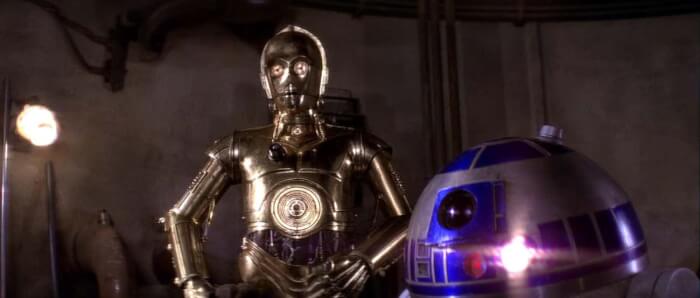 Source: Star Wars / 20th Century Fox
Source: Star Wars / 20th Century Fox
The C-3PO suit would get better with time, but it would always have flaws. Daniels, who is consistently professional, flatly rejected when J.J. Abrams asked him if he wanted to only voice C-3PO for The Force Awakens and have another actor don the droid costume. "I couldn't possibly have done the voice alone. This integration is C-3PO."
In the animated television series The Lord of the Rings from 1978, Daniels also provided the voice of Legolas.
#12 Robert Englund
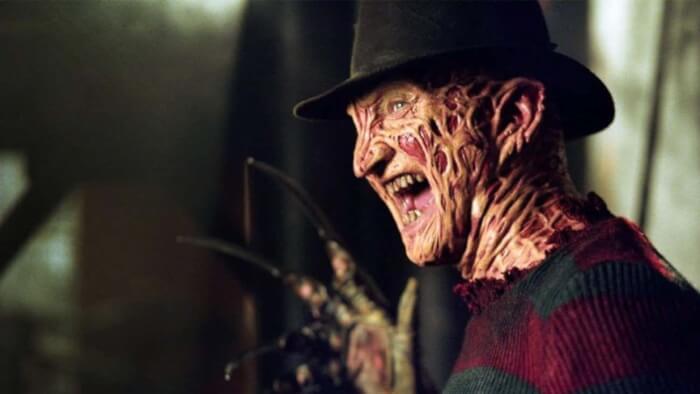 Source: A Nightmare on Elm Street / New Line Cinema
Source: A Nightmare on Elm Street / New Line Cinema
The fact that Freddy Krueger stalks his victims when they are asleep is what makes him so horrifying. He resides in their psyches and subsists on their terror. Because the villain is having so much pleasure in frightening his victims, Englund plays Krueger in a somewhat campy manner.
Englund had a lengthy acting career. Even in his early work as an episodic television actor in the 1970s and 1980s on programs like Soap, Charlie's Angels, and CHiPS, we can recognize his face. His big-screen debut was on the science fiction show V.
Englund was given the lead role in Wes Craven's 1984 film A Nightmare on Elm Street, and even though he has over 160 acting and voiceover credits to his name, Freddy Krueger will always be the character for which Englund is best known. This is true even though his face is essentially unrecognizable in the role.
Wes Craven described how Englund came up with the character's essence on his own:
"As a director, you're always trying to do that. For instance, with Robert Englund, I always encouraged him to make [Freddy] his own. In fact, from casting on, I realized the power of that man. He was ready and enthusiastic about exploring that persona in a way that came from his own imagination, as well as mine. The physicality of the character, for instance, was not necessarily on the page; much of it was Robert experimenting and improvising based on a theme. It's a little bit like Miles Davis's Kind of Blue. The melody lines for that album's songs were very simple, and they had these great players go into the recording studio - John Coltrane and Gil Evans and so forth - and they came out with something that's based on the melody lines, but everybody brought their own genius to it through improvisation. That was the secret of that film in Robert's case; he was able to take the ball and run with it."
#13 H. Jon Benjamin
Beginning his career in show business as a comic, H. Jon Benjamin joined forces with David Cross to create the Cross Comedy group. In addition to his roles as Bob Belcher in Bob's Burgers, Carl from Family Guy, Ben from Dr. Katz, Professional Therapist, and a can of vegetables from Wet Hot American Summer, he is also recognized for his voice work as Sterling Archer in the ridiculous spy series Archer. A successful comedic writer, Benjamin has written for shows like Bob's Burgers and The Jenny McCarthy Show.Benjamin won the award for a best male comedic performer at the Vulture TV Awards for his roles in Bob's Burgers and Archer. For his portrayal of the egotistical, womanizing spy Archer in 2009, he was also nominated for an Emmy in the category of Outstanding Voice-Over Performance.
Despite having strong filmography, Benjamin doesn't think he is particularly skilled in his field. He stated: "When Loren [Bouchard, the man behind Bob's Burgers], casts me in a role, I'm never happy. I don't think my voice-acting skills are particularly strong. There are some exceptionally talented character actors and impressionists, such as Larry Murphy as Teddy and Dave Herman as Mr. Frond. I've just thought of a simple approach to alter the tone of my voice."
Benjamin is a skilled voiceover artist because of his ability to vary his voice. The characteristics of Archer's voice and Bob Belcher's voice are very different. Benjamin is able to take the character's personalities and produce a tone that is exactly right for the subject matter.
#14 Bill Skarsgård
 Source: Chapter One / Warner Bros.
Source: Chapter One / Warner Bros.
Skarsgrd played Pennywise the Dancing Clown, one of the scariest horror movie villains of the modern era. In the 2017 Stephen King adaption It and the 2019 follow-up It Chapter Two, he played the spooky, white-faced clown.
In both television and movies, terrifying clowns have appeared frequently. Why is Skarsgrd's interpretation of Pennywise so terrifying? It's not even about the bloodied clown outfit or makeup. He demonstrated that even the smallest facial movement can conjure up something absolutely evil by flashing the horrifying Pennywise smile on Instagram without the need for CGI or makeup.
James McAvoy, a fellow actor, acknowledged that he was utterly afraid while they were filming It Chapter Two because of Skarsgrd. The Scottish actor claimed in an interview from 2019 that "He's incredible. Skarsgrd is dreadful. He's a pretty nice person, yet he creeped me out a lot. I recall being there with the rest of the cast, all these adults, and doing crazy, freaky things with everyone. We are all saying, "I don't like being here," as we all turn to face one another. I don't enjoy acting in today's world."
Share this article
Advertisement
